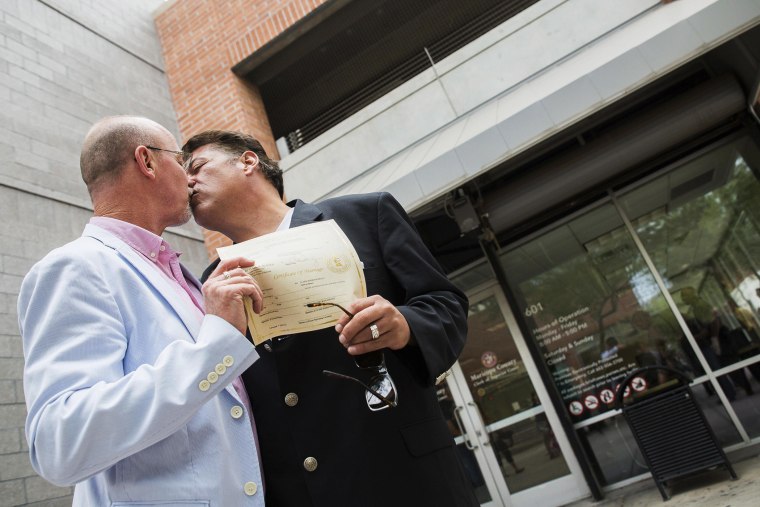Question: How many days does it take for the marriage equality landscape to turn completely on its head?
Answer: 11.
Less than two weeks ago, there were 19 states plus the District of Columbia where gay and lesbian couples could legally wed, and 31 states where they could not. But with a federal judge's ruling that struck down Arizona's same-sex marriage ban on Friday, and the U.S. Supreme Court's decision hours later to let marriage equality go forward in Alaska, the number of states where gay and lesbian couples could legally wed shot up to 31 plus the District of Columbia, leaving just 19 states still banning the practice -- exactly the opposite of where we were eleven days ago.
What accounts for the sudden switch? Two Mondays ago, the U.S. Supreme Court rejected appeals to hear challenges against bans in Indiana, Oklahoma, Utah, Virginia, and Wisconsin, a move that immediately legalized marriage equality in those five states. Because the action deferred to rulings in favor of same-sex nuptials from the 4th, 7th, and 10th Circuit Courts of Appeals, it also doomed bans in six other states under those courts' jurisdiction. A day after the Supreme Court's move, another federal appeals court — the 9th Circuit — struck down marriage laws in Idaho and Nevada, essentially making bans in three other states bound to that appellate ruling impossible to defend.
Related: Five questions about marriage equality, answered
For those keeping count, the combined effect of those two court actions means that 35 states plus the District of Columbia will soon allow gay and lesbian couples to legally wed.
Several elected officials have vowed to continue defending their bans, however, so marriage equality's march to 35 isn't quite completed yet. But one by one, from the desert to the ice, bans are dropping like flies.
“It is clear,” wrote U.S. District Judge John Sedwick, a President George W. Bush appointee who struck down Arizona’s same-sex marriage ban Friday, “that an appeal to the Ninth Circuit would be futile. It is also clear – based on the Supreme Court’s denial of [appeals] filed in connection with several circuit court decisions which held that same-sex marriage must be recognized in Indiana, Oklahoma, Utah, Virginia, and Wisconsin – that the High Court will turn a deaf ear on any request for relief from the Ninth Circuit’s decision.”
Related: Married same-sex couples in seven more states to receive federal recognition
Hours after Sedwick's ruling came down, Justice Anthony Kennedy denied a request from Alaska officials to halt a decision that overturned that state's same-sex marriage ban. U.S. District Judge Timothy M. Burgess, another President George W. Bush appointee, struck down Alaska’s 1998 amendment on Sunday that defined marriage as an institution between one man and one woman. It was the nation's oldest voter-approved ban on same-sex nuptials.
The perfect 31 to 19 flip won't last for long -- nothing does when it comes to marriage equality. Later in the day Friday, U.S. District Judge Scott W. Skavdahl struck down Wyoming's same-sex marriage ban, a move that will bring the number of states where gay and lesbian couples can legally wed to 32. Skavdahl put his ruling on hold until 5 p.m. Thursday, so gay and lesbian couples won't be able to marry in that state until next week. In the meantime, onlookers can bask in the symmetry brought about by the last eleven days for a little while longer.
